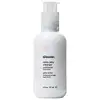What's inside
What's inside
 Key Ingredients
Key Ingredients

 Benefits
Benefits

 Concerns
Concerns

 Ingredients Side-by-side
Ingredients Side-by-side

Water
Skin ConditioningIsopropyl Isostearate
EmollientButylene Glycol
HumectantGlycerin
HumectantCetyl Alcohol
EmollientPrunus Amygdalus Dulcis Oil
Skin ConditioningRicinus Communis Seed Oil
MaskingSimmondsia Chinensis Seed Oil
EmollientPalmitoyl Grape Seed Extract
Skin ConditioningSodium Cocoyl Glutamate
CleansingCarbomer
Emulsion StabilisingDecyl Glucoside
CleansingButyrospermum Parkii Butter Extract
Skin ConditioningMaltodextrin
AbsorbentXanthan Gum
EmulsifyingPotassium Cetyl Phosphate
EmulsifyingCaprylyl Glycol
EmollientPotassium Sorbate
PreservativeSodium Hydroxide
BufferingTocopherol
AntioxidantHelianthus Annuus Seed Oil
EmollientAvena Sativa Kernel Extract
AbrasiveCentaurea Cyanus Flower Extract
AstringentParfum
MaskingWater, Isopropyl Isostearate, Butylene Glycol, Glycerin, Cetyl Alcohol, Prunus Amygdalus Dulcis Oil, Ricinus Communis Seed Oil, Simmondsia Chinensis Seed Oil, Palmitoyl Grape Seed Extract, Sodium Cocoyl Glutamate, Carbomer, Decyl Glucoside, Butyrospermum Parkii Butter Extract, Maltodextrin, Xanthan Gum, Potassium Cetyl Phosphate, Caprylyl Glycol, Potassium Sorbate, Sodium Hydroxide, Tocopherol, Helianthus Annuus Seed Oil, Avena Sativa Kernel Extract, Centaurea Cyanus Flower Extract, Parfum
Water
Skin ConditioningRosa Damascena Flower Water
MaskingGlycerin
HumectantPropanediol
SolventIsohexadecane
EmollientAcrylamide/Sodium Acryloyldimethyltaurate Copolymer
Emulsion StabilisingSodium Hyaluronate
HumectantPanthenol
Skin ConditioningAllantoin
Skin ConditioningSymphytum Officinale Root Extract
Skin ConditioningXylitylglucoside
HumectantBetaine
HumectantAnhydroxylitol
HumectantXylitol
HumectantAmmonium Polyacryloyldimethyl Taurate
Emulsion StabilisingEthylhexylglycerin
Skin ConditioningPolysorbate 80
EmulsifyingSorbitan Oleate
EmulsifyingBenzoic Acid
MaskingCitric Acid
BufferingSodium Hydroxide
BufferingPotassium Sorbate
PreservativeSodium Benzoate
MaskingGeraniol
PerfumingCitronellol
PerfumingWater, Rosa Damascena Flower Water, Glycerin, Propanediol, Isohexadecane, Acrylamide/Sodium Acryloyldimethyltaurate Copolymer, Sodium Hyaluronate, Panthenol, Allantoin, Symphytum Officinale Root Extract, Xylitylglucoside, Betaine, Anhydroxylitol, Xylitol, Ammonium Polyacryloyldimethyl Taurate, Ethylhexylglycerin, Polysorbate 80, Sorbitan Oleate, Benzoic Acid, Citric Acid, Sodium Hydroxide, Potassium Sorbate, Sodium Benzoate, Geraniol, Citronellol
 Reviews
Reviews

Ingredients Explained
These ingredients are found in both products.
Ingredients higher up in an ingredient list are typically present in a larger amount.
Glycerin is already naturally found in your skin. It helps moisturize and protect your skin.
A study from 2016 found glycerin to be more effective as a humectant than AHAs and hyaluronic acid.
As a humectant, it helps the skin stay hydrated by pulling moisture to your skin. The low molecular weight of glycerin allows it to pull moisture into the deeper layers of your skin.
Hydrated skin improves your skin barrier; Your skin barrier helps protect against irritants and bacteria.
Glycerin has also been found to have antimicrobial and antiviral properties. Due to these properties, glycerin is often used in wound and burn treatments.
In cosmetics, glycerin is usually derived from plants such as soybean or palm. However, it can also be sourced from animals, such as tallow or animal fat.
This ingredient is organic, colorless, odorless, and non-toxic.
Glycerin is the name for this ingredient in American English. British English uses Glycerol/Glycerine.
Learn more about GlycerinPotassium Sorbate is a preservative used to prevent yeast and mold in products. It is commonly found in both cosmetic and food products.
This ingredient comes from potassium salt derived from sorbic acid. Sorbic acid is a natural antibiotic and effective against fungus.
Both potassium sorbate and sorbic acid can be found in baked goods, cheeses, dried meats, dried fruit, ice cream, pickles, wine, yogurt, and more.
You'll often find this ingredient used with other preservatives.
Learn more about Potassium SorbateSodium Hydroxide is also known as lye or caustic soda. It is used to adjust the pH of products; many ingredients require a specific pH to be effective.
In small amounts, sodium hydroxide is considered safe to use. However, large amounts may cause chemical burns due to its high alkaline.
Your skin has a natural pH and acid mantle. This acid mantle helps prevent harmful bacteria from breaking through. The acid mantle also helps keep your skin hydrated.
"Alkaline" refers to a high pH level. A low pH level would be considered acidic.
Learn more about Sodium HydroxideWater. It's the most common cosmetic ingredient of all. You'll usually see it at the top of ingredient lists, meaning that it makes up the largest part of the product.
So why is it so popular? Water most often acts as a solvent - this means that it helps dissolve other ingredients into the formulation.
You'll also recognize water as that liquid we all need to stay alive. If you see this, drink a glass of water. Stay hydrated!
Learn more about Water